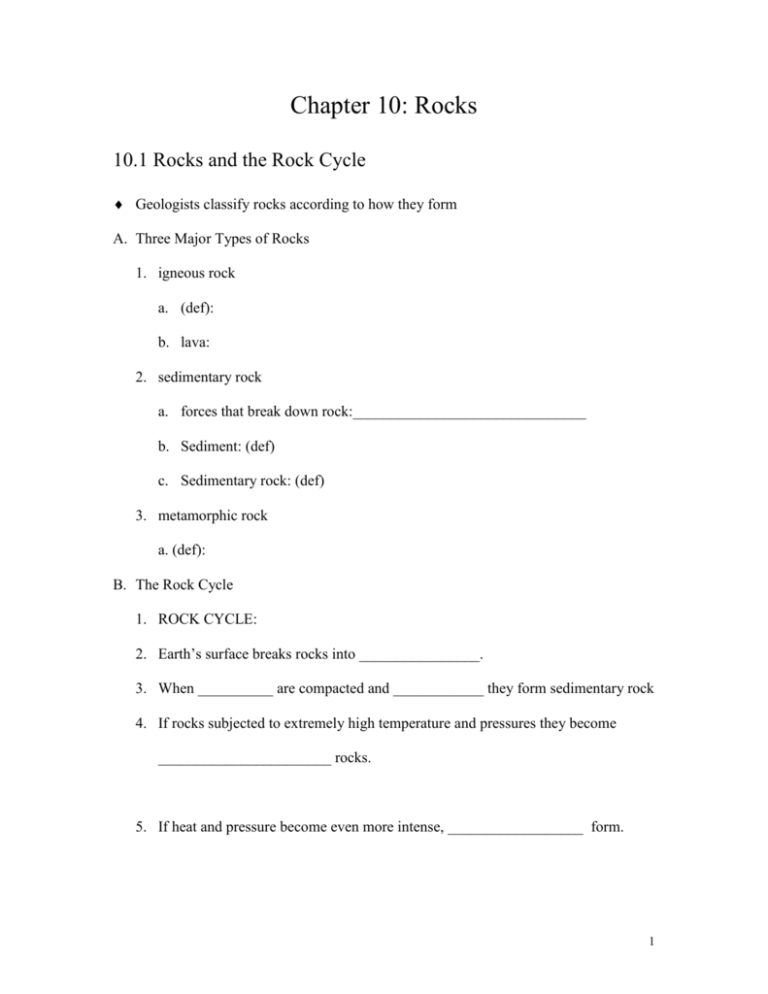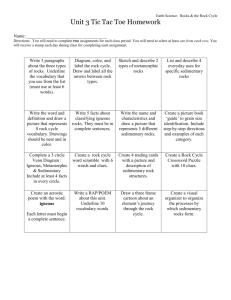Chapter 10: Rocks
advertisement

Chapter 10: Rocks 10.1 Rocks and the Rock Cycle Geologists classify rocks according to how they form A. Three Major Types of Rocks 1. igneous rock a. (def): b. lava: 2. sedimentary rock a. forces that break down rock:_______________________________ b. Sediment: (def) c. Sedimentary rock: (def) 3. metamorphic rock a. (def): B. The Rock Cycle 1. ROCK CYCLE: 2. Earth’s surface breaks rocks into ________________. 3. When __________ are compacted and ____________ they form sedimentary rock 4. If rocks subjected to extremely high temperature and pressures they become _______________________ rocks. 5. If heat and pressure become even more intense, __________________ form. 1 10.2 Igneous Rock Two groups of igneous rock 1. Intrusive igneous rock: 2. Extrusive igneous rock: Texture: -determined by the _________________ rate I. Texture of Igneous rock A. When do intrusive rocks form? B. Example of coarse grain:________________ C. When do extrusive rocks form? D. What produces a fine-grained rock? E. The oceanic crust is mainly composed of _________________. F. Porphyritic: (def) II. Composition of Igneous Rocks A. The mineral composition of igneous rock is determined by:___________________________________________________________ B. Three igneous rock families 1. Felsic a. high in __________________ b. light colored c. main mineral components _____________ & _______________ 2 2. Mafic a. _______________ in silica b. rich in ________________ & __________________ c. main components ________________________ & _______________________________________ d. dark colored 3. Intermediate a. medium colored b. rocks in this family contain less_______________ than felsic rocks III. Igneous Rock Structures A. Intrusions: (def) 1. Batholith: (def) a. form core of many mountain ranges 2. Stock: (def) 3. Laccolith: (def) a. frequently found in groups b. small dome shaped mountains 4. Sill: (def) a. lies parallel to rock layers 5. Dike: (def) a. common in areas of volcanic activity 3 B. Extrusions: (def) 1. Volcanic neck: (def) 2. Lava plateau: (def) 10. 3 Sedimentary Rock Two processes the form sedimentary rock 1. Compaction: (def) 2. Cementation: (def) I. Formation of Sedimentary Rocks A. Clastic Sedimentary Rocks: (def) 1. Classified by the size of sediments they contain 2. Gravel sized grains a. Conglomerate: (def) b. Breccia: (def) 3. Sand sized grains a. ___________ is the major component of sandstone 4. Clay sized particles a. Shale b. Usually pressed into flat layers that will easily split apart 4 1. Chemical Sedimentary Rocks: (def) 1. How does chemical limestone form? 2. Evaporites: (def) 3. Two examples of sedimentary rock formed by rapid evaporation a. ________________ & _________________ B. Organic Sedimentary Rock: (def) 1. ________________ & ________________ are examples 2. How does organic limestone form? II. Sedimentary Rock Features A. Stratification: (def) 1. What is cross-bedding? B. Ripple Marks and Mud Cracks 1. How are rippled marks formed? 2. How do mud cracks form? C. Fossils: (def) D. Concretions: (def) 1. Geode: (def) 5 10.4 Metamorphic Rock Metamorphism: (def) I. Formation of Metamorphic Rock A. Two types of metamorphism 1. Contact metamorphism: (def) 2. Regional metamorphism: (def) a. occurs during periods of tectonic activity b. most metamorphic rock is formed by regional metamorphism II. Classification of Metamorphic Rocks A. Foliated Rocks: (def) 1. form in 2 ways a. extreme pressure flattens the crystals into bands b. minerals of different densities separate 2. How is slate formed? 3. How is schist formed? 4. How is gneiss formed? B. Non-Foliated Rocks: (def) 1. Quartzite is very hard and durable 2. What rock is compressed limestone? 6







